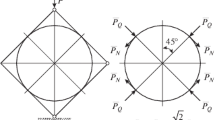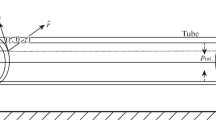Abstract
A thermal shock ΔT was applied to the surface of tube-sheet models of 10 percent and 33 1/3 percent ligament efficiency. By means of a thin slice cemented with a reflective cement, it was posible to obtain photo-elastically the surface-stress variation with time. By extrapolation, maximum stresses of 0.93 and 1.04\(E_p \alpha _p - \Delta T_p /(1 - v_p )\) were obtained at zero time for the 10 percent and 33 1/3 percent ligament efficiencies, respectively.
Details of the experimental techniques employed are presented, together with the assumptions and calculations required to obtain the variation with time of the stresses at the ligament edges on the tube-shee surface.
Using the effective elastic constants and stress-intensification factors for tube sheets subjected to isotropic biaxial-plane stress, thermal stresses of 1.18 and 1.31\(E_p \alpha _p \Delta _p \Delta T_v /(1 - v_p )\) were calculated for ligament efficiency of 10 and 33 1/3 percent, respectively. It is felt that these are uppe limits for the thermal stresses.
Similar content being viewed by others
Abbreviations
- x, y :
-
coordinates in the plane of the surface
- ϕ:
-
angular position around a hole, measured fromy-axis
- z :
-
coordinate perpendicular to plane of surface
- H :
-
thickness of reflelctive slice
- t :
-
model time
- t p :
-
prototype time
- T :
-
temperature of model at any distancez at any timet
- T 0 :
-
initial ambient temperature
- T−T 0 :
-
temperature change, °C
- T s :
-
Temperature of surface
- T a :
-
average temperature betweenz=0 andz=H
- ΔH :
-
T s =T 0 , thermal shock in model, ° C
- ΔT p :
-
thermal shock in prototype, ° C
- f :
-
model material fringe value, psi/fringe/in
- E :
-
model modulus of elasticity, psi
- α:
-
model coefficient of thermal expanison, in./in./° C
- ν:
-
model Poisson’s ratio
- E p ,α p ,v p :
-
prototype constants
- n 0 :
-
initial fringe order at ligament edges
- n t :
-
fringe order at ligament edges after thermal shock
- n ea :
-
n t −n o , fringe order averaged through thicknessH
- σ ea :
-
stress at ligament edge averaged through thicknessH
- σ es :
-
(Ts/Ta)σ ea = ligament edge stress at surfacez=0
- σ p :
-
prototype stress at ligament edges on the surface
- m/m p :
-
ratio of thermal diffusivity of model to prototype
- v*,E*:
-
effective elastic constants for tube sheets
- F x=y :
-
stress-intensification factor for tube sheets subjected to plane-biaxial stressσ x =σ y
- \((\sigma _\phi /\sigma _y )_{x = y}\) :
-
ratio of hole-boundary stress to hominal plane biaxial stress,σ x =σ y , based on unperforated plate
References
Horway, G., “The Plance-Stress Problems of Perforated Plate, Jnl. Appl. Mech., 19 (3)355–360 (1952).
Malkin, I., “Notes on a Theoretical Basis for Design of Tuber Sheets of Triangular Layout,”Trans. ASME, 74, 387–396 (1952).
Gardaner, K. A., “Heat Exchanger Tube Sheet Design,”Jnl. Appl. Mech., 15, 377–385 (1948).
Duncan, J. P., “The Structural Efficiency of Tube-Plastes for Heat Exchangers,”Proc. Inst. Mech. Engrs., 169 (39),789–810 (1955).
O’Donnell, W. J., and Langer, B. F., “Design of Perforated Plates,” ASME Trans., Series B, 1962, Jnl. Engl. Ind., 307–319.
Boley, B. A., andWeiner, J. H., “Theory of Thermal Stresses,”John Wiley and Sons, New York, 1960.
Leven, M. M., “Stress Distribution in a Perforated Plate of 10% Ligament Efficiency Subjected to Equal Biaxial Stress,” Westinghouse Research Report 64-520-R1, March 17, 1964.
Tramposch, H., andGerard, G., “The Physical Properties of Several Materials for Use in Photothermoelastic Investigations,”Jnl. Appl. Mech., 25 (4)525–528 (1958).
Sampson, R. C., “Photoelastic Frozen Stress Study of the Effective Elastic Constants of Perforated Materials, A Progress Report,” WAPD-DLE-319, May 1959, Availabe from the Office of Technical Services, Department of Commerce, Washington 25, D. C.
Sampson, R. C., “Photoelastic Analysis of Stresses in Perforated Material Subject to Tension or Bending,” Bettis Technical Review, WAPD-BT-18, April 1960, Available from the Office of Technical Services, Department of Commerce, Washington 25, D. C.
Sampson, R. C., “Effect of Material Poisson’s Ratio on the Effective Elalstic Constants of Perforated Bars in Bending,” Westinghouse Research Report 10-0509-7-R4, April 1960.
Author information
Authors and Affiliations
Rights and permissions
About this article
Cite this article
Leven, M.M., Johnson, R.L. Thermal stresses on the surface of tube-sheet plates of 10 and 33 1/3 percent ligament efficiency. Experimental Mechanics 4, 356–365 (1964). https://doi.org/10.1007/BF02322794
Issue Date:
DOI: https://doi.org/10.1007/BF02322794




